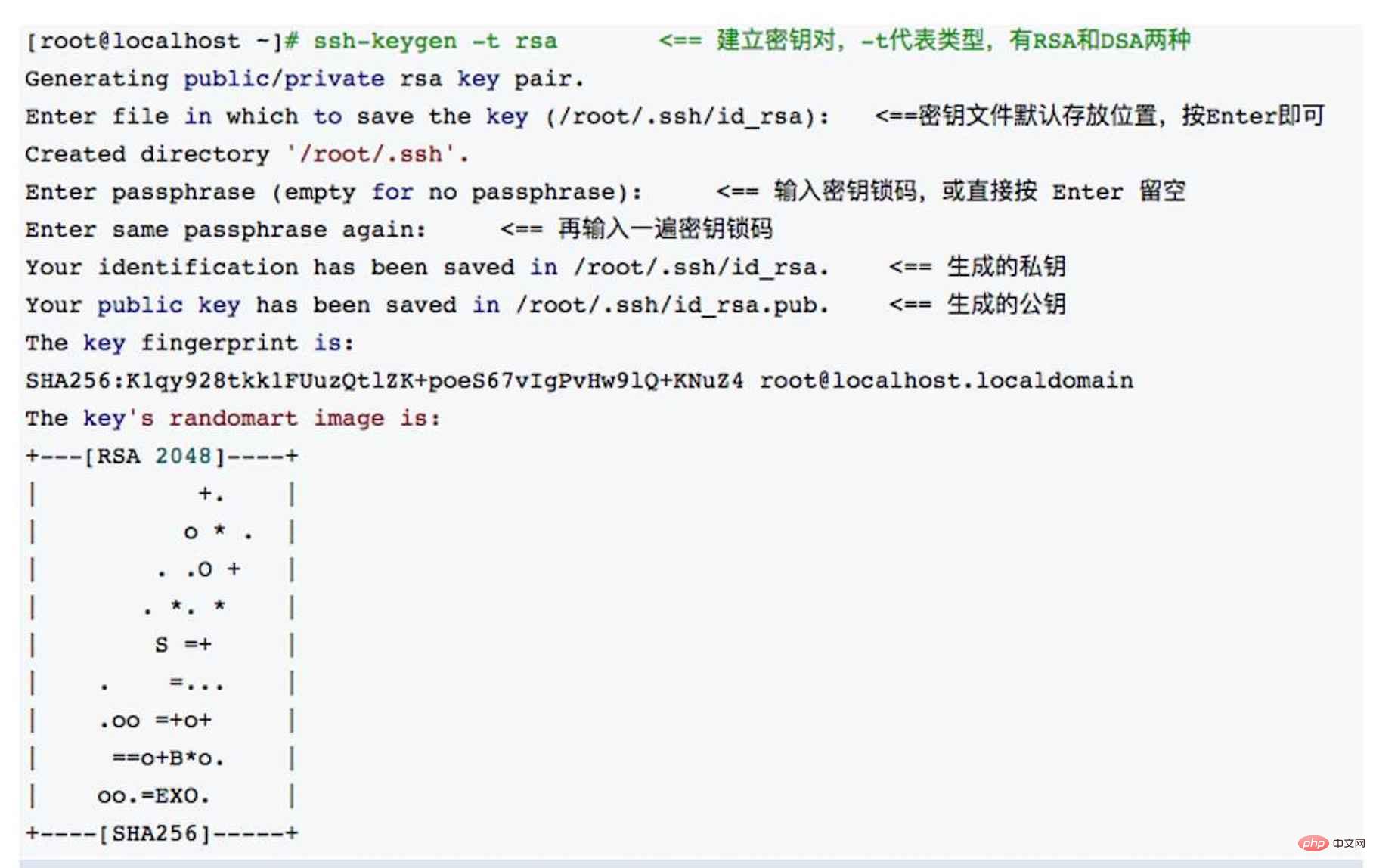What is the use of linux ssh?
Ssh is used to remotely log in to the Linux server to manage and maintain the system. SSH is a protocol designed to provide security for remote login sessions and other network services; using the ssh service (referring to software that implements the SSH protocol), you can remotely log in to the server to manage and maintain the system, preventing information leakage during remote management.

#The operating environment of this tutorial: linux5.9.8 system, Dell G3 computer.
1 What is ssh in linux? What is the use?
(1) ssh is a protocol
SSH (Secure Shell) is more reliable and designed for remote login sessions and Other network services provide security protocols, and the use of the SSH protocol can effectively prevent information leakage during remote management.
(2) ssh service
Linux is generally used as a server. We usually use the ssh service (referring to the software that implements the SSH protocol) to log in remotely. Go to the Linux server to manage and maintain the system.
- OpenSSH is a free and open source implementation of the SSH (Secure SHell) protocol.
- OpenSSH server: sshd (Linux server starts the service)
- OpenSSH client: ssh (client starts, access the server through it)
2 What is the key-based security verification process of ssh?
You need to create a pair of keys and put the public key on the server. When connecting to the SSH server, the client sends a request to the server and uses your public key for security verification. After the server receives the request, it first searches for your public key in your home directory on the server, and then compares it with yours. The public key sent is compared. If the two keys match, the server encrypts the "challenge" with the public key and sends it to the client software. After the client software receives the "challenge", it can decrypt it with your private key.
3 What is the difference between symmetric encryption and asymmetric encryption?
(1) Symmetric encryption
The same key (secret) is used for encryption and decryption key). Highly efficient, a major drawback of symmetric encryption is the management and distribution of keys. During the process of sending keys, there is a great risk that the keys will be intercepted by hackers. The common practice in reality is to asymmetrically encrypt the symmetric encryption key and then transmit it to the person who needs it.
(2) Asymmetric encryption
Asymmetric encryption provides a very secure method for data encryption and decryption. It uses A pair of keys, public key and private key. The private key can only be kept securely by one party and cannot be leaked, while the public key can be sent to anyone who requests it. Asymmetric encryption uses one of the keys in the pair for encryption, while decryption requires the other key. Currently the most commonly used asymmetric encryption algorithm is the RSA algorithm. Although asymmetric encryption is very secure, it is very slow compared to symmetric encryption, so we still have to use symmetric encryption to transmit messages, but the key used in symmetric encryption can be sent out through asymmetric encryption.
4 The role of asymmetric encryption RSA algorithm
(1) Encryption: public key encryption private key decryption
Mainly used to encrypt data to prevent it from being illegally obtained by others to ensure data security. The data is encrypted using the public key, and only the private key can decrypt it. Even if the ciphertext is obtained by a third party on the Internet, it cannot be decrypted without the private key, thus ensuring data security.
- A generates an RSA key file on his computer, a private key file and a public key file, and sends his public key to B.
- At this time, B wants to send information to A, so B uses A's public key to encrypt his message and then sends it to A. (The ciphertext transmitted on the network cannot be decrypted without A's private key, and it will be useless after others obtain it)
- A uses his private key to decrypt B's message.
(2) Authentication: Private key encryption and public key decryption
is mainly used for identity verification to determine the authenticity of a certain identity sex. After encrypting with the private key, decrypt it with the corresponding public key to verify the authenticity of the identity.
SSH public key login uses the second function.
5 How to generate ssh key pair?

- After running the above command, a pair of public and private keys will be generated, which will be saved in id_rsa, id_rsa.pub under ~/.ssh/ by default.
- id_rsa is the private key and id_rsa.pub is the public key. The private key must be kept properly.
- The permissions of id_rsa must be 600, chmod 600 ~/.ssh/id_rsa. 600 means (-rw------) only the owner has read and write permissions.
6 ssh configuration config file and quick login
(1) Quick login configuration
You can define some shortcut key login configurations under ~/.ssh/. The configuration is in ~/.ssh/config
config structure is as follows:
Host kafka_broker_01 #定义主机别名 ServerAliveInterval 30 HostName 122.22.222.102 #主机ip Port 33033 #ssh 端口 User bila #用户名 IdentityFile /Users/bila/.ssh/id_rsa #私钥 ProxyCommand ssh w_x_bastion -C -W %h:%p #设置跳板机
(2) Login
Specify user login
ssh bila@192.168.0.103
Specify port number login
ssh ssh 192.168.0.103 -p 2022
Related recommendations: "Linux Video Tutorial"
The above is the detailed content of What is the use of linux ssh?. For more information, please follow other related articles on the PHP Chinese website!

Hot AI Tools

Undresser.AI Undress
AI-powered app for creating realistic nude photos

AI Clothes Remover
Online AI tool for removing clothes from photos.

Undress AI Tool
Undress images for free

Clothoff.io
AI clothes remover

Video Face Swap
Swap faces in any video effortlessly with our completely free AI face swap tool!

Hot Article

Hot Tools

Notepad++7.3.1
Easy-to-use and free code editor

SublimeText3 Chinese version
Chinese version, very easy to use

Zend Studio 13.0.1
Powerful PHP integrated development environment

Dreamweaver CS6
Visual web development tools

SublimeText3 Mac version
God-level code editing software (SublimeText3)

Hot Topics
 1387
1387
 52
52
 How to use docker desktop
Apr 15, 2025 am 11:45 AM
How to use docker desktop
Apr 15, 2025 am 11:45 AM
How to use Docker Desktop? Docker Desktop is a tool for running Docker containers on local machines. The steps to use include: 1. Install Docker Desktop; 2. Start Docker Desktop; 3. Create Docker image (using Dockerfile); 4. Build Docker image (using docker build); 5. Run Docker container (using docker run).
 How to view the docker process
Apr 15, 2025 am 11:48 AM
How to view the docker process
Apr 15, 2025 am 11:48 AM
Docker process viewing method: 1. Docker CLI command: docker ps; 2. Systemd CLI command: systemctl status docker; 3. Docker Compose CLI command: docker-compose ps; 4. Process Explorer (Windows); 5. /proc directory (Linux).
 What to do if the docker image fails
Apr 15, 2025 am 11:21 AM
What to do if the docker image fails
Apr 15, 2025 am 11:21 AM
Troubleshooting steps for failed Docker image build: Check Dockerfile syntax and dependency version. Check if the build context contains the required source code and dependencies. View the build log for error details. Use the --target option to build a hierarchical phase to identify failure points. Make sure to use the latest version of Docker engine. Build the image with --t [image-name]:debug mode to debug the problem. Check disk space and make sure it is sufficient. Disable SELinux to prevent interference with the build process. Ask community platforms for help, provide Dockerfiles and build log descriptions for more specific suggestions.
 What computer configuration is required for vscode
Apr 15, 2025 pm 09:48 PM
What computer configuration is required for vscode
Apr 15, 2025 pm 09:48 PM
VS Code system requirements: Operating system: Windows 10 and above, macOS 10.12 and above, Linux distribution processor: minimum 1.6 GHz, recommended 2.0 GHz and above memory: minimum 512 MB, recommended 4 GB and above storage space: minimum 250 MB, recommended 1 GB and above other requirements: stable network connection, Xorg/Wayland (Linux)
 vscode cannot install extension
Apr 15, 2025 pm 07:18 PM
vscode cannot install extension
Apr 15, 2025 pm 07:18 PM
The reasons for the installation of VS Code extensions may be: network instability, insufficient permissions, system compatibility issues, VS Code version is too old, antivirus software or firewall interference. By checking network connections, permissions, log files, updating VS Code, disabling security software, and restarting VS Code or computers, you can gradually troubleshoot and resolve issues.
 Can vscode be used for mac
Apr 15, 2025 pm 07:36 PM
Can vscode be used for mac
Apr 15, 2025 pm 07:36 PM
VS Code is available on Mac. It has powerful extensions, Git integration, terminal and debugger, and also offers a wealth of setup options. However, for particularly large projects or highly professional development, VS Code may have performance or functional limitations.
 What is vscode What is vscode for?
Apr 15, 2025 pm 06:45 PM
What is vscode What is vscode for?
Apr 15, 2025 pm 06:45 PM
VS Code is the full name Visual Studio Code, which is a free and open source cross-platform code editor and development environment developed by Microsoft. It supports a wide range of programming languages and provides syntax highlighting, code automatic completion, code snippets and smart prompts to improve development efficiency. Through a rich extension ecosystem, users can add extensions to specific needs and languages, such as debuggers, code formatting tools, and Git integrations. VS Code also includes an intuitive debugger that helps quickly find and resolve bugs in your code.
 How to back up vscode settings and extensions
Apr 15, 2025 pm 05:18 PM
How to back up vscode settings and extensions
Apr 15, 2025 pm 05:18 PM
How to back up VS Code configurations and extensions? Manually backup the settings file: Copy the key JSON files (settings.json, keybindings.json, extensions.json) to a safe location. Take advantage of VS Code synchronization: enable synchronization with your GitHub account to automatically back up all relevant settings and extensions. Use third-party tools: Back up configurations with reliable tools and provide richer features such as version control and incremental backups.




